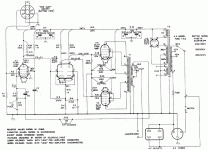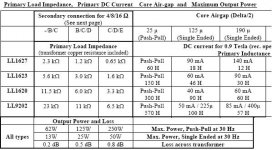Attached is the primary load impedance configuration for the models of Lundahl transformer.
I'm sorry, I'm a newbie and I really don't know how to figure out the transformer.
But by guessing with the data, looks like LL1620 & LL9202 should be able to do the job?
If yes which is better suite?
I'm sorry, I'm a newbie and I really don't know how to figure out the transformer.
But by guessing with the data, looks like LL1620 & LL9202 should be able to do the job?
If yes which is better suite?
Attachments
Yes, they're close on the primary impedance. Do they have the 43% screen taps?
Leak amps are notorious for a falling low end below 50 Hz. So if you're trying to recapture that Leak "sound," use the one with the lower inductance and the smaller core. From the spec sheet fragment you posted, it would appear to be the 1620.
And if I were you, I wouldn't hesitate to ask Lundahl directly. They may have a transformer from a different series that might be closer to what you're looking for.
Leak amps are notorious for a falling low end below 50 Hz. So if you're trying to recapture that Leak "sound," use the one with the lower inductance and the smaller core. From the spec sheet fragment you posted, it would appear to be the 1620.
And if I were you, I wouldn't hesitate to ask Lundahl directly. They may have a transformer from a different series that might be closer to what you're looking for.
Hi,
I found this pdf article interesting. The author sets out to design an improved Mullard 5-20 amp, which uses EL34 tubes in UL. He explains why he selected the Lundahl LL1663 OPT.
I found this pdf article interesting. The author sets out to design an improved Mullard 5-20 amp, which uses EL34 tubes in UL. He explains why he selected the Lundahl LL1663 OPT.
Those (LL1620, LL1623, LL1627 and LL9202) are listed on Lundahl website and can get of the shelf.
They can be connected as 50% screen tap.
LL1663 is a 5k:8 ohms
LL1664 is a 3k:8 ohms
LL1682 is a 5.5k:5 ohms
all seems not to be able to drive 4 ohms speaker.
The original Leak TL/25 Plus use a 7k ohms and 49% screen tap.
So how this will affect the sound if I use 6k ohms and 50% screen tap (LL1620)? Especially the 1k ohms lower impedance compare to original.
They can be connected as 50% screen tap.
LL1663 is a 5k:8 ohms
LL1664 is a 3k:8 ohms
LL1682 is a 5.5k:5 ohms
all seems not to be able to drive 4 ohms speaker.
The original Leak TL/25 Plus use a 7k ohms and 49% screen tap.
So how this will affect the sound if I use 6k ohms and 50% screen tap (LL1620)? Especially the 1k ohms lower impedance compare to original.
Let me try to disabuse you of some things and make your life easier:
1. There is no such thing as a 4 ohm speaker. Impedances of ANY real-world speaker vary all over the place. If you've got a typical box speaker, you may well find that its impedance runs from 3 to 25 ohms, depending on the frequency. If I were dictator, I wouldn't allow manufacturers to quote nominal impedances or power-handling figures without proper context.
2. Transformers are just dumb impedance converters. That is, a transformer won't have a primary impedance of (say) 6Kohm. Its primary impedance will vary as the load varies, but in a fixed ratio. And that ratio is the critical spec. For example, if your transformer is rated 6K primary, 5 ohm secondary, what that means is that IF you have a 5 ohm resistor (not a speaker!), the primary will present a 6K load to the output tubes. If you connect a 10 ohm resistor to the secondary, the primary will present a 12K load. Same transformer. So it is somewhat meaningless to say, hey, with that rating, the transformer won't drive a 4 ohm speaker; it will, but that speaker will be reflected as a 4.8K load with that transformer.
All that said, let's look at what happens with a pure resistive load. Mullard's data indicate that between 6K and 7K, the power is about the same, total distortion at 20W output is about the same, and required drive voltage is about the same. If the load resistance decreases below 6K, the power drops and the distortion rises. Going the other way, if the load resistance increases, the power drops a bit, but the distortion stays about the same.
1. There is no such thing as a 4 ohm speaker. Impedances of ANY real-world speaker vary all over the place. If you've got a typical box speaker, you may well find that its impedance runs from 3 to 25 ohms, depending on the frequency. If I were dictator, I wouldn't allow manufacturers to quote nominal impedances or power-handling figures without proper context.
2. Transformers are just dumb impedance converters. That is, a transformer won't have a primary impedance of (say) 6Kohm. Its primary impedance will vary as the load varies, but in a fixed ratio. And that ratio is the critical spec. For example, if your transformer is rated 6K primary, 5 ohm secondary, what that means is that IF you have a 5 ohm resistor (not a speaker!), the primary will present a 6K load to the output tubes. If you connect a 10 ohm resistor to the secondary, the primary will present a 12K load. Same transformer. So it is somewhat meaningless to say, hey, with that rating, the transformer won't drive a 4 ohm speaker; it will, but that speaker will be reflected as a 4.8K load with that transformer.
All that said, let's look at what happens with a pure resistive load. Mullard's data indicate that between 6K and 7K, the power is about the same, total distortion at 20W output is about the same, and required drive voltage is about the same. If the load resistance decreases below 6K, the power drops and the distortion rises. Going the other way, if the load resistance increases, the power drops a bit, but the distortion stays about the same.
I don't know where you are located, but if it's in the UK one option for a drop in transformer is the 'bigger' Danbury 6.6K (VT1041) at £48, which I use myself in my rebuilt Leak TL25s. It's a thicker core version of the Maplin 6.6K OPT - another cheap alternative at £30 each. See http://www.livinginthepast.demon.co.uk/xformer.html
I switched my output valves to EH7591s, which can be driven by a 6J5 type (using 7193/2C22) into a concertina (12B4)
I switched my output valves to EH7591s, which can be driven by a 6J5 type (using 7193/2C22) into a concertina (12B4)
avxt said:Thats means for optimum performance I still need a transformer that convert 6/7k to 4 ohms rite.
Do you know where can I download the original mullard 5-20 design article or information? (I have the 5-20 schematic)
No, that means that although you THINK you have 4 ohm speakers, you don't. You could call them "5 ohm" just as easily. You're not trying to drive a resistor (at least I hope not!), you're trying to drive a loudspeaker, a complex and tremendously variable load. Bottom line: don't sweat the difference between 4 and 5 ohm.
I'm sure a net search (or even a search of diyAudio.com) will yield a 5-20 schematic. If not, the Mullard tube book has been reprinted, available through AudioXpress. And I think it's also reprinted in Morgan Jone's "Valve Amplifiers", which is a book you ought to have anyway.
I don't know if you have but try e-mailing stephenspicer@telstra.com he may be able to supply the winding layout for you.He supplied the information for me to be able to get a pair of opt's wound for a Leak stereo 60. He may take a little time to get back to you but he has always been very helpful.
nkg
nkg
- Status
- This old topic is closed. If you want to reopen this topic, contact a moderator using the "Report Post" button.
- Home
- Amplifiers
- Tubes / Valves
- Leak tl/25+ OPT selection

